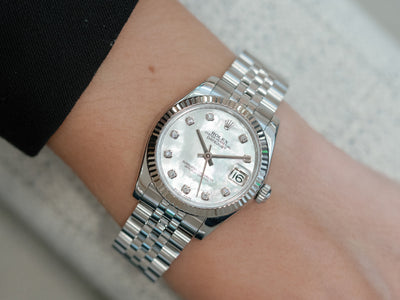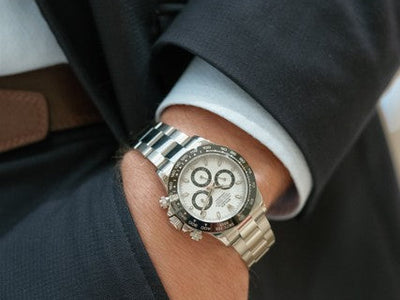Luxury, beauty, vibrancy—these words are synonymous with rubies. If you’re searching for a timeless and colorful gemstone design, ruby jewelry is the perfect choice, whatever your style. Before shopping for a ruby bracelet or ruby earrings of your own, consider getting an expert's inside look at the historical meaning, powerful symbolism, and design elements that bring the magic of ruby jewelry to life.
What Are Rubies?
Named after the Latin word “ruber,” meaning red, the ruby is a specific precious gemstone variety of the corundum mineral known best for its rich color and durability. Rubies are often referred to as one of the cardinal gemstones, alongside amethyst, sapphire, emerald, and diamond.
How Are Rubies Formed and Why Are They Red?
Did you know that natural rubies take 20 to 30 million years to form? While captivating in that ruby bracelet, ruby gemstones, scientifically called corundum, are a form of crystalline aluminum oxide that once was buried deep beneath Earth’s crust.
A combination of extreme heat and high pressure caused oxygen and aluminum atoms to combine and form the corundum. When chromium is present, it results in the vibrant red hue that rubies are famous for.
Rubies vs. Sapphires
Fun fact alert: Rubies and sapphires are essentially the same stone! Both fall under the corundum mineral family and share the same hardness scale rating and crystalline structure.
The main difference between the two gems is determined by the presence of trace elements. Chromium makes the corundum red, and those stones are rubies. If iron and titanium are present, the corundum is considered a sapphire and can be blue, yellow, pink, or a variety of other colors.
Where Are Rubies Found?
Millions of years ago, rubies formed in environments with superheated, mineral-rich waters with low silica and low iron levels. Since rubies require the addition of chromium, a rare element, natural rubies are discovered in specific areas, including:
- Myanmar
- Mozambique
- Greenland
- Sri Lanka
- Thailand
- Madagascar
- Afghanistan
- Pakistan
- Tanzania
The Importance of Ruby Jewelry Around the World
From ruby necklaces to ruby rings and more, these dazzling red gemstones have been used in different cultures throughout time. Discover how ruby jewelry is viewed around the globe to understand its significance for yourself.
Warriors Wore Ruby Jewelry in Burmese Culture
Long ago in Burma (now known as Myanmar), the blood-red shade of rubies became a strong, symbolic connection to human blood for warriors. Ancient Burmese soldiers claimed it as their signature stone, believing it granted them complete invulnerability in battle.
To get this protection, they had to do more than wear a ruby bracelet or multi-shape diamond and ruby ring—fighters had the gem surgically embedded directly underneath the skin in combat-vulnerable areas like the chest, shoulders, and upper arms. Doing so was thought to make the warrior’s body impenetrable to weapons and provide a permanent protective barrier.
Ancient Indians Cured the Body with Ruby Jewelry
The Ancient Indians believed in a similar connection between human blood and red rubies, but rather than using them in battle, they employed the glittering gems for healing purposes. Convinced that ruby jewelry had the power to reduce inflammation, strengthen the heart, and even cure bleeding disorders, the people incorporated the stone into the Ayurvedic medicine practice. Someone suffering one of those ailments would be instructed to wear a ruby necklace 24/7 or meditate with the red gem to balance chakras.
Europe’s Medical Use of Ruby Jewelry in the Renaissance
When rubies were imported to Europe in the Middle Ages, they were immediately deemed beautiful, stylish, and even, in some instances, transformative. Similar medical applications to those used in India have been reported around Europe at that time, specifically in the renowned 16th-century physician Paracelsus’s use of powdered ruby for ailments like cancer and ulcers. His hypothesis was that, due to the ruby’s vibrant red color, it should be able to restore vitality to damaged tissue.
Healing Properties Said to Be Associated with Ruby Jewelry
- Enhance courage and confidence
- Help erase negative thoughts
- Encourage everlasting love and commitment
- Increase wealth and bring abundance
- Aid in fertility, digestion, and detoxification
- Strengthen the circulatory system
- Soothe arthritis and rheumatism
The Top Considerations and Questions to Ask Yourself When Buying Ruby Jewelry
If you’re searching for a romantic ruby necklace for your 40th-anniversary gift or ruby earrings as a “treat yourself” purchase, you’ll want a well-rounded understanding of what sets ruby jewelry apart. As you browse ruby bracelets, rings, and more, keep these design elements and questions in mind to ensure a perfect fit:
What Type of Ruby Is Featured in the Jewelry Piece?
When it comes to ruby jewelry, gems are often categorized depending on the country or region from which they are mined. This can affect both the overall value of a piece and the color of the stone. Though they can be found in other areas, these are the most popular types of rubies found in luxury ruby necklaces and diamond and ruby rings:
- Burmese rubies: praised for being the best quality, known for their deep red color
- Thai rubies: often considered second in quality, feature deeper yet less intense brown-red colors
- Madagascar rubies: a more recent contender, offer vivid red and pink undertones
- Afghanistan rubies: from one of the oldest mining locations, with hues ranging from light to deep red
Can You Wear Ruby Jewelry Daily?
Rubies are a highly durable gemstone, making them perfect for everyday accessorizing. With a lack of cleavage planes and a rank of 9 on the Mohs scale, second only to diamonds, rubies are incredibly hard, meaning they are chip-resistant and less likely to break than other precious gemstones.
If you’re interested in adding a ruby necklace that pairs with any outfit to your collection or a ruby ring to your wedding stack, you can rest assured it’s a good choice. The gemstone will be able to withstand your day-to-day lifestyle.
Is Ruby Jewelry Affordable?
Though rubies are incredibly valuable (especially when naturally formed), they are considerably less expensive than diamonds, making them the premier choice for fine jewelry lovers on a budget. Very high-end and rare ruby necklaces can be far more expensive, with thousands or millions of dollars per carat, but the majority of ruby jewelry designs available are nearer to under $100 per carat, particularly when featuring lab-created stones.
Is a Treated Ruby Less Valuable?
Many world-renowned companies use heat treatments to improve the color and clarity of fine rubies for designs like yellow gold cable ruby bracelets with great results. But does it affect the final price tag? In short, yes.
While treatments are a common and widely accepted practice, it does mean that the stones will be slightly less valuable than their natural, untreated counterparts. However, if you fall in love with a pair of ruby earrings that utilize heat-treated stones or fracture-filling methods, don’t discount them—they still boast magnificent beauty and value.
Ruby Gemstone Shades
When it comes to designing or buying a stylish ruby bracelet, the color of each gem matters the most. The finest ruby jewelry pieces exhibit a bright, saturated red hue. Huggie hoop ruby earrings with orange or purple overtones are considered of less value. If a color is too dark, it detracts from a stone’s brightness; if a color is too light, the stone may be categorized as a pink sapphire instead.
Rubies are famously known to exhibit secondary colors, also referred to as undertones. A slight purple undertone can make the red even more vibrant, making it the preferred secondary color. Orange hues give the ruby a warmer appearance, but if it’s too bold, the color can lower the stone’s value. Some rubies even have a subtle pink color, giving them a romantic glow!
When it comes down to it, stone color is a personal preference. There are plenty of ruby rings, ruby bracelets, ruby earrings, and more designs available in each shade.
What’s the Most Popular Ruby Color?
With a bold name and even bolder color, Pigeon’s Blood rubies remain the most popular choice for ruby jewelry around the world. With a deep saturation, vibrant red primary color, and slight blue undertones, a Pigeon’s Blood ruby has a perfectly subtle purple tint. Fiery, desirable, and completely timeless, Pigeon’s Blood ruby jewelry is the best of the best.
3 Additional Terms for Describing a Ruby’s Colorful Appearance:
- Tone: refers to how light or dark the shade is—if it’s too dark, it’s difficult to make out the color, but if it’s too light, the color will be too faint to see. Ideally, the tone falls between medium and medium dark.
- Saturation: refers to the depth of a ruby’s color—the more intense the color, the more valuable the ruby necklace becomes.
- Fluorescence: refers to the striking phenomenon of ruby bracelets glowing under ultraviolet light.
Does Cut Matter for Ruby Jewelry?
Like diamonds, the way a ruby is shaped and cut makes a world of difference in its brilliant appearance, but it’s not the most important value factor. Ruby necklaces are well known for their fiery colors, not their brilliance like diamonds are.
A high-quality cut will maximize the light return and glowing hue of a ruby. When one correctly understands a gem cutter, one will be able to maximize the color and carat weight of a stone, minimize the inclusions, and strive to create the cuts desired by consumers.
Most Common Shapes in Ruby Jewelry
There is no “best” shape for a ruby. If you come across a clover-shaped diamond and ruby necklace with a round cut and fall in love with it, who’s to tell you that it’s not right? When you’re browsing ruby earrings, keep an eye out for some of the most popular gemstone shapes to find your perfect pair:
- Oval
- Cushion
- Emerald
- Pear
- Marquise
What is Ruby Clarity?
Clarity almost always plays a massive role in the value of a gemstone, and ruby jewelry is no different. When experts reference a ruby’s clarity, they’re talking about the size, number, location, and color of the imperfections or inclusions within the stone.
To measure the clarity of a colorful stone, gemologists follow an “eye-cleanliness” rule, meaning the stone is clear of inclusions when viewed with the naked eye. The better the clarity, the more expensive the ruby ring becomes.
How Does Carat Affect the Value of Ruby Jewelry?
Contrary to the well-known gold-related term “karat,” a carat with a c refers to the ruby’s weight. As one could assume, the heavier the carat weight, the bigger the price tag. Larger gems are rarer than small gems, but take it from the professionals—whatever your budget, there’s a perfectly sized and weighted ruby jewelry design available for you.
What’s the Most Flattering Metal Choice for Ruby Jewelry?
When it comes to choosing the best designs for your jewelry box, you’ll want to pick the most flattering metals for your skin tone and outfits. Luckily, rubies look elegant in a wide variety of settings.
Yellow gold ruby necklaces give the gem a warm, almost vintage feel, while something brighter, like sterling silver or platinum, offers a higher contrast and helps the ruby stand out. As you shop for diamond drop ruby earrings, consider which metal feels the most wearable to you.
Can You Use a Ruby Ring to Propose?
With a durable score on the Mohs hardness scale and passionate symbolism throughout history, ruby rings make a wonderful choice for popping the question! In fact, modern brides are leaning more and more towards colorful gemstone engagement rings, as opposed to traditional diamonds. Whether you’re shopping together or on your own, consider buying an eternally beautiful octagon ruby ring for the momentous occasion.
Insider tip: if your loved one has a July birthday, consider shopping for designs with their birthstone, the ruby! Sporting a birthstone ruby ring is thought to bring luck to its wearer—and who couldn’t use a bit of that?
Throughout time, countless cultures have imbued the ruby with great importance. When you see the captivating red beauty for yourself in ruby jewelry designs, it’s easy to see why! With an age-old reputation for being a royal gemstone, rubies are more than just a precious gem—they’re meaningful.













